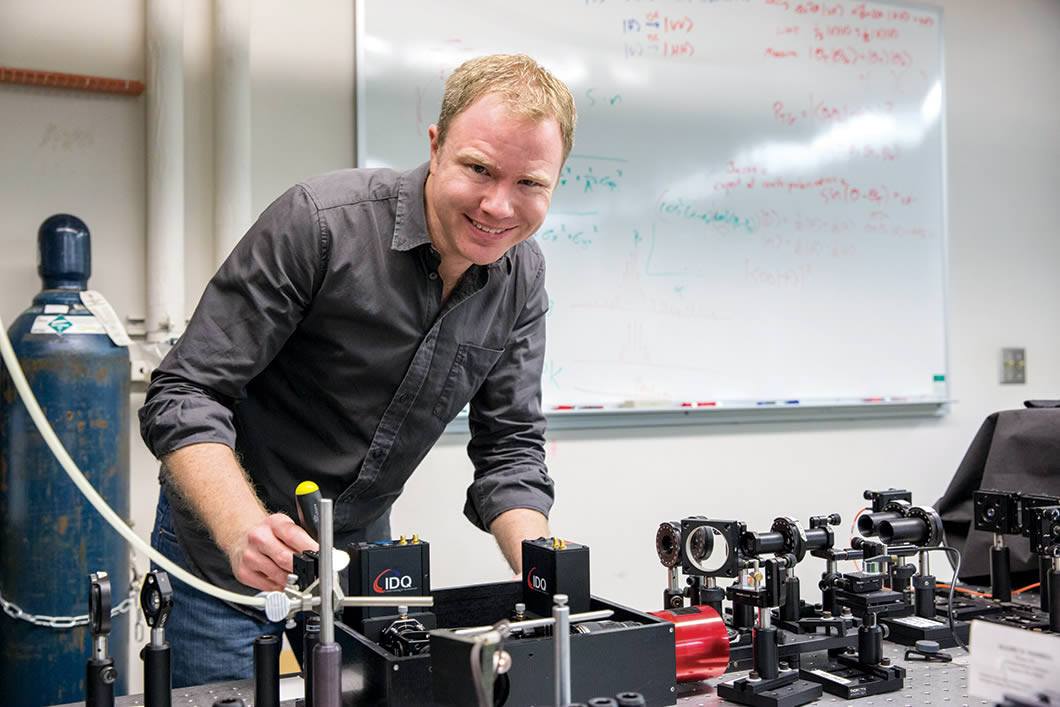Faculty News
Researchers Seek Astronomical Answers to Quantum Questions
Last summer, mathematics and physics double major Calvin Leung ’17 and physics major Amy Brown ’17 built an inconspicuous-looking instrument that performs a rather remarkable task. The device, a black box that could be confused for a piece of camera equipment, generates random numbers using photons from astronomical sources. Successful tests of the device were an early step in research they are doing with Assistant Professor of Physics Jason Gallicchio, who devised an idea to use starlight to improve tests of quantum mechanics. Gallicchio and Leung are co-authors, along with their colleagues, on the paper “A Cosmic Bell Test with Measurement Settings from Astronomical Sources,” recently published by Physical Review Letters.
Gallicchio studies experimental cosmology, the study of the origin and evolution of the universe. The paper aims to close a loophole in tests of physicist John Bell’s inequalities—which confirm the “spooky action at a distance” between quantum entangled particles—by using telescopes that look at widely separated stars to generate the random settings in experiments on quantum entanglement. “This particular project is interesting and different,” Gallicchio explains, “because it combines astrophysics and quantum mechanics; things on big, distant scales and things that we tend to think of as being on tiny scales. We’re using light that’s coming from far, far away as a tool to do tests of quantum mechanics.”

If you hope that there’s some locality-friendly thing happening under quantum mechanics, it’s much less plausible now.
—JASON GALLICCHIO, ASSISTANT PROFESSOR OF PHYSICS
Albert Einstein was famously uncomfortable with quantum mechanics because it didn’t fit with his physical realist attitude toward physics. Initially, beginning in the early 1930s, the discussion around the mysterious aspects of quantum mechanics seemed like a philosophical debate. Then, in 1964, Bell looked at it as an experimental question, stating that if straightforward implementations of Einstein’s theory of relativity held, tests would give results different than what quantum mechanics predicts. Since that time, all experiments have confirmed quantum mechanics, but they leave open loopholes that could, in principle, still allow an explanation that would satisfy Einstein’s strong preference for local influences.
The “free will” or “freedom-of-choice” loophole suggests that seemingly randomly selected measurement settings could have been affected by some unknown cause and therefore have influenced the results of tests on quantum entangled particles. It’s also a problem if results could be predicted, even if they couldn’t have been influenced. By using 600-year-old starlight to determine the random measurement settings, Gallicchio and his colleagues are able to show that if there is an underlying influence at work, it has to have been working for at least that long to have affected any influence or prediction.
Gallicchio’s idea to use light from stars as a tool to generate random measurements came to him when he was an undergrad, taking one class in the philosophy of physics and another in quantum mechanics. He developed his idea further, writing the first draft of the paper during a year spent at the South Pole studying the cosmic microwave background. He returned to the U.S. and later flew to Vienna, Austria, to work on convincing his colleagues there, including leading physicists and cosmologists, to perform the experiments, which generated exciting results. “With starlight, it’s harder to say there’s something happening that can be explained locally,” Gallicchio says. “If you hope that there’s some locality-friendly thing happening under quantum mechanics, it’s much less plausible now.”
Though the experiment was performed in Vienna, Gallicchio is currently working with other students to build an improved version of this experiment at Harvey Mudd, which would be an exciting development on any scale.